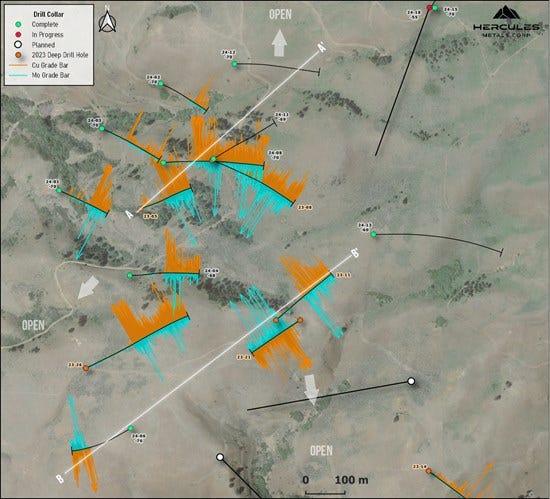It is always nice to be a little bit right. I suggested that the long wait for the BIG news release didn’t signify “bad news” but rather complicated good news. Thursday’s press release was exactly that.
Hercules Metals’ (BIG.V) headline, Hercules Metals Intersects 480 Meters of 0.47% Cu, 82 ppm Mo, including 55 Meters of 1.5% Cu, was pure good news. Those are minable copper values. For me, however, the really good news is in this figure from the release:
The biggest knock against BIG is that its “blind copper porphyry” and associated mineralization were too deep and too “low grade”. Based on the figure above, the “Enrichment Blanket” is only 200 meters from surface and no one would call 1.47% copper “low grade. Plus, that blanket is a very attractive 50+ meters thick based on the two holes assayed so far. We’re waiting for assays from two more holes which will very likely confirm the extension of the enrichment blanket.
Chris Paul, CEO of Hercules, is quoted in the release, “The phyllic cap and hypogene enrichment blanket have expanded now to 1.6 km x 1.1 km, leading to new interpretations of the potential geometry and scale of the system.”
The market reacted with a $0.10 or 20% bounce taking BIG from $0.50 to $0.60 which, while gratifying, reflects the complexity of the results released. Hercules geos, Barrick geos, Bayhorse (BHS.V), Rio Tinto and Scout geos will be updating their analysis of the geology and structures characteristic of the Izee/Olds Ferry sutures.
While everyone is focused on copper, the BIG release also has some intriguing silver results,
Broad zones of disseminated silver-lead-zinc occur within the Hercules Rhyolite, an important unit of the Jurassic cover sequence. Although no longer the primary target, with commodities prices on the rise, the near surface silver mineralization may play an important role in potential future development scenarios.
Solid, near-surface rhyolite-hosted silver values will be no surprise to Bayhorse’s Dr. Clay Conway.
Mineral deposit settings and relations at Bayhorse/Pegasus have similarities to those in the Cuddy Mountains district and also the Mineral district about 10 km north of Bayhorse mine. At each, silver mineralization is associated with rhyolite which is found at or near the regional contact between the Triassic-Jurassic Huntington Formation and the unconformably overlying Jurassic Weatherby Formation. Thus, silver mineralization at all three is potentially coeval – generated in the same regional magmatic episode. (italics mine) (link)
Complicated releases always take the market a while to digest. Today’s bounce was largely a response to the excellent headline but the release will get a closer reading in the next few days.
One critical thing the release contained is the fact that additional assays are expected and that drilling, with two diamond rigs and a reverse circulation drill, is ongoing. If the weather holds, more of the drilling plan is likely to be completed this drilling season so there should be a steady news flow right into the New Year.
Goldfinger is hosting an “X” spaces tomorrow with CEO Chris Paul Friday at noon Eastern, 9 Pacific. https://twitter.com/i/spaces/1OwGWNrAbPQKQ
Meanwhile, for my Canadian readers, Happy Thanksgiving! Canadian markets will be closed on Monday so Friday is the last day to stock up on either BIG or BHS.
(Disclaimer: I hold a small position in Hercules Metals. I own shares in Bayhorse Silver and may purchase or sell at any time. This is not investment advice. Do your own due diligence. Call the CEO.)




